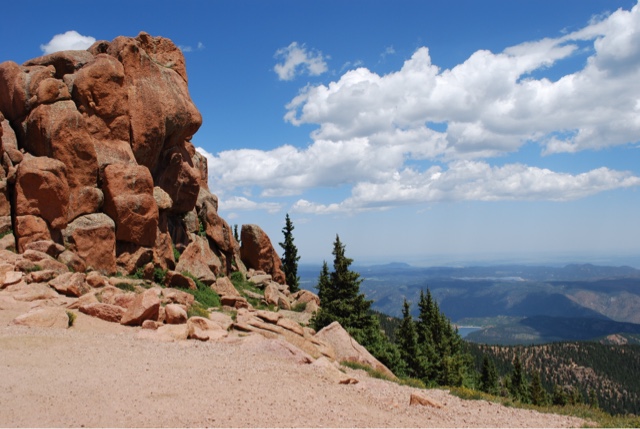
Jim drove up to the top of Pike's Peak today. Here are his pictures, and some information from their website.
The most visited mountain in North America and the second most visited mountain in the world behind Japan's Mount Fuji, Pikes Peak forms a stunning backdrop for Colorado Springs and the Garden of the Gods. At an altitude of 14,115 feet above sea level, Pikes Peak is the 31st highest peak out of 54 Colorado peaks. It is the farthest east of the big peaks in the Rocky Mountain chain, which contributed to its early fame among explorers, pioneers and immigrants and made it the symbol of the 1859 Gold Rush to Colorado with the slogan, "Pikes Peak or Bust".

The 8.9-mile Cog Railway started operating year round in 2007 weather permitting. Over a half million people reach the Summit House every year by the Pikes Peak Highway, Barr Trail or the Pikes Peak Cog Railway.
The 19-mile Pikes Peak Highway is paved to the summit and is open year round, weather permitting. Barr Trail is the longest of any trails leading to the top of the 54 mountains in Colorado that are over 14,000 feet and offers the greatest base-to-summit elevation gain in the state - 7,400 feet.
About 15,000 people a year attempt to climb Pikes Peak on foot. The 13-mile Barr Trail begins at the base of Pikes Peak in Manitou Springs.
He has reached the Peak.
Below: Colorado Springs
Four notable events take place on the mountain each year. The Pikes Peak Ascent and Marathon, a 26-mile round trip foot race up Barr Trail and then back down each August, draws thousands of runners from all over the world.
The current Pikes Peak Marathon record, which was set in 1993, is 3 hours 16 minutes 30 seconds. The second event, the Pikes Peak International Hill Climb is a race on the 12.42-mile road, which starts around the 6 1/2 mile mark on the highway.
In 2013, Sebastian Loeb set a new record of 8 minutes 13.878 seconds.
The third event is the Pikes Peak Challenge, an annual fundraiser for The Brain Injury Alliance of Colorado. The fourth event is the AdAmAn Club New Year's Fireworks display on December 31 at midnight.





Some of the Wildlife of Pike's Peak:
Yellow - Bellied Marmot (whistle pig): Close relative of the woodchuck of the East and Midwest and the largest of the ground squirrel family. Brown in color with white areas on the chin and a yellowish belly (hence the name). Adults weigh up to 11 pounds and are about 26 inches in length. During hibernation the marmot will loose half of its summer weight. Insufficient fat or a burrow too shallow to prevent freezing will cause marmots to not arouse in the spring. Mating season starts as soon as there is green forage available. Gestation takes 30 days; approximately three to eight offspring are born and weaned in 20 to 30 days. Preferred foods are flowering stalks and assorted grasses. Marmots live in colonies with a single male and several females. Predators are less of a problem than the stress of hibernation. Marmots are protected by their rocky habitat and the social system of alarm calls. 
Bighorn Sheep: The Bighorn Sheep is the state animal. Colorado is home to the largest {2} population of the species anywhere. The animals are 5 to 6 feet long with a tail 3 to 6 inches in length. Rams weigh 150 to 250 pounds, ewes weigh 123 to 200 pounds. Males are 3 feet high at the shoulders, ewes slightly less. Grayish brown in color with a white rump patch. The massive, coiled horns make up 10% of the body weight. Ewes have spike-like horns. Bighorns are grazers and eat over 100 different types of plants, feeding in meadows, open woodland and alpine tundra. They often retreat to rest on inaccessible cliffs. Pikes Peak has a herd of about 250 to 300 head that stay near timberline year round. The rut (mating season) takes place in the late fall, with the rams butting their massive horns to assert their dominance in order to get their chance of breeding. Females breed after they are 3 years old; gestation period is 6 months; a single lamb is born in May or June.
Black Bear: Colorado's largest carnivores: 4 - 6 feet long and weighing 200 - 450 pounds. They are black (or occasionally brown) in color. Black Bears are omnivores, eating about anything in good supply- fruit, nuts, honey (bees, waxy comb and all), young deer and elk, birds, eggs, insects. Their only enemy is humans. Mating occurs in the summer; 2 or 3 cubs (9 ounces) about the size of two or three fists are born to a sleeping mother during hibernation. The cubs will emerge from the den five weeks later after their weight has doubled four to five times, to 6-9 pounds, and the young play among themselves. The cubs don't reach full size until about five years of age. Females breed every other year. Longevity in the wild may exceed 20 years.





















Beautiful photos! I remember that drive. There was a lot of wind and t-storms in the area when a friend and I were there last. I don't think I'll ever do that drive, again. It was pretty wild on the way down, somewhat like descending through a thunderstorm.
ReplyDeleteJim said, it is something you will never forget.
ReplyDelete